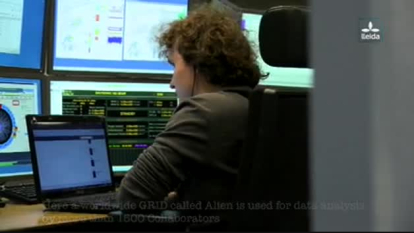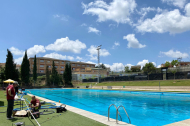What does a young software engineer at CERN do?
Technical Student at CERN

In the recent days, after receiving the Women in ICT award in the category of University Student, there are many people that want to know more details about the work I do at the European Organization for Nuclear Research (CERN), where I now do the internship and write my thesis for my master degree in software engineering. This is the reason I'm writing this article: to explain, or at least try, what I do at CERN - the largest particle physics laboratory in the world.
CERN is an immense organization. Its facilities are so large that we can compare it to a city where twelve thousand scientists work. One of its peculiarities is that it straddles the border between France and Switzerland. Thus as my rental apartment is in France, but my office is on Swiss territory, every day I cross the border at least twice, making the living and working experience even more international. The areas of study on which scientists base their work are very varied and at the same time complementary for the development of the most innovative and pioneering research in particle physics.
Multiple experiments, from small to immense scale, are carried out to bring us closer to understanding the origin of the universe and to study the indivisible components that make up the atoms, the so-called elementary particles - quarks - and the forces that bind them together - gluons. Evidence of the existence of these subatomic particles is found through observations of the collisions of atoms that occur in the largest and most powerful particle accelerator on the planet, the so-called Large Hadron Collider (LHC). This accelerator is located in a tunnel with a circular perimeter of 27 kilometers and buried about 100 meters underground. Inside the accelerator, two beams of particles travel in opposite directions. The beams are driven by the force generated by very powerful electromagnetic fields - up to 100,000 times the Earth's magnetic field - created by a set of superconducting magnets. The path that the tunnel follows not only goes around the CERN facilities, but also passes through the subsoil of the surrounding villages. It’s a bit funny to think that below my apartment, or below the supermarket, particles may be passing uninterruptedly at the highest speed that has ever been achieved on planet Earth.
CERN Audiovisual Media
When particles are accelerated to a speed close to that of light, the beams are matched at 4 points and the opposing beams collide. At these points there are different detectors , which observe the collisions and where all the data and measurements are extracted. The LHC hosts four main experiments, each of these focuses on research in a specific field of particle physics. Specifically, the experiment I work on is called ALICE (A Large Ion Collider Experiment). The immense magnitude of its detector is summed up in these four quantities: weighing about 10,000 tons and measuring 26 meters long, 16 meters high and 16 meters wide. The ALICE detector registers approximately 50,000 particle collisions per second. Within the detector, different instruments measure the collision properties, such as energy, speed and trajectory.The measurement process could be compared to a high resolution picture of each of the collisions that takes place.
In short, if we take into account the sheer number of collisions and the multitude of measured parameters, the amount of generated data is of high order of magnitude. To give you an idea, the volume of data per second, 3.5 TB, is equal to 474 hours of video - almost 20 days - in Full HD quality. If we tried to use my phone’s memory - a 64GB iPhone 11 - to store data as it was extracted, within 18 milliseconds (18 thousands of a second) it would be full. We would need 56 iPhone units to fit 1 second of recording! But only with the extracted data we don’t go anywhere. It is necessary to process and analyze it in order to understand what is happening and to be able to study and explain the origin of the physics phenomena we observe in our daily lives. Although one may think that the study of such small particles has no implications for our daily lives, discoveries made at CERN have revolutionized modern physics. One of the most recent is that of the Higgs boson, which has allowed us to find the explanation of a basic phenomenon in our concept of matter: mass. The ALICE experiment itself is studying the primordial state of matter called the Quark-Gluon Plasma, which existed up to a few millionths of a second after the Big Bang and from which the ordinary matter we observe today was created.
CERN Audiovisual Media
In order to carry out these studies, a lot of calculations using complex algorithms have to be made. These require massive amounts of storage and computing power. The challenge is that we have to use hundreds of thousands computers at once, located at about 100 computing centres around the world, working together on the same task and on the large volumes of data collected by the detectors. The orchestration of these computers is done by a system, in charge of the work coordination and data distribution. Here comes into play the section where I work. We are in charge of writing the software that orchestrates the data processing and distribution and makes sure that the physicists can analyze the results quickly and efficiently. The network of researchers collaborating in all areas of the experiment is distributed around the world. Yes, you got it right, there are about 2,000 researchers in ALICE contributing to the physics analysis from their home institutions. Similar number of researchers are working on each of the other 3 large LHC experiments.
he computing centres we use are spread across the planet. They range from small (few hundred servers) to large (tens of thousands of servers) and each of them has its own characteristics and peculiarities, to which we must adapt. In order to make the most efficient use of each server , we try to find the best way to adapt the orchestration software and to find solutions to the challenges that their use may pose. Specifically, the work I do has the ultimate goal of adapting our software so that it can be used in one of the most powerful systems available nowadays: supercomputers.
CERN Audiovisual Media
The area where I work is, as you may have deduced, a key piece to the advancement of particle physics. Without the large computing infrastructure to analyze the data extracted from the particle collisions, many of the discoveries that have led us to a better understanding of the interior of matter — what we and the rest of the universe are made of — would have never occurred. CERN, being such a multidisciplinary research institute, actively promotes the diversity of research to achieve the discoveries and technological advances that have taken place in its facilities. Without going any further, just to mention one ubiquitous tool used by billions of people - the World Wide Web which was born at CERN. Technology developed at CERN is used to make important contributions in the field of medicine, such as the development of therapies for the treatment of cancer and other diseases using radioisotopes, or to develop the detectors used in magnetic resonance imaging. This shows that the intense research in physics done in this large laboratory is also useful for the research and introduction of new tools and methods with applications in a wide variety of industries.
CERN Audiovisual Media
For sure the research carried out at CERN has a great future ahead, with physics discoveries that will lead us to better understand what surrounds us, and that will lead to a large number of parallel developments that will be used in different applications in all areas of society. During the months I have been working here, I have seen how the boundaries of computer science have been pushed forward, driving computing centres to the highest levels of efficiency. I have worked in a multicultural environment, with professionals very motivated by their work and driven by a common vision to achieve the best results possible. The CERN facilities are, without a doubt, a must-see stop for those curious who want to know more details about its research and everything that has been discovered there. Through guided tours and its large science exhibition, you will be able to experience an immersion in particle physics that will amaze you.

Marta Bertran




